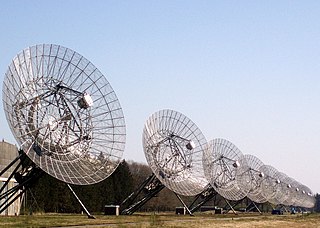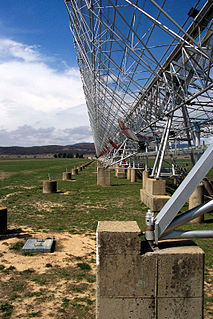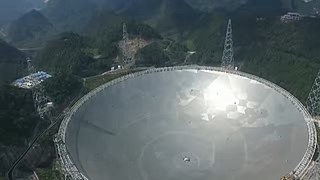
A radio telescope is a specialized antenna and radio receiver used to detect radio waves from astronomical radio sources in the sky. Radio telescopes are the main observing instrument used in radio astronomy, which studies the radio frequency portion of the electromagnetic spectrum emitted by astronomical objects, just as optical telescopes are the main observing instrument used in traditional optical astronomy which studies the light wave portion of the spectrum coming from astronomical objects. Unlike optical telescopes, radio telescopes can be used in the daytime as well as at night.

The Karl G. Jansky Very Large Array (VLA) is a centimeter-wavelength radio astronomy observatory located in central New Mexico on the Plains of San Agustin, between the towns of Magdalena and Datil, ~50 miles (80 km) west of Socorro. The VLA comprises twenty-eight 25-meter radio telescopes deployed in a Y-shaped array and all the equipment, instrumentation, and computing power to function as an interferometer. Each of the massive telescopes is mounted on double parallel railroad tracks, so the radius and density of the array can be transformed to adjust the balance between its angular resolution and its surface brightness sensitivity. Astronomers using the VLA have made key observations of black holes and protoplanetary disks around young stars, discovered magnetic filaments and traced complex gas motions at the Milky Way's center, probed the Universe's cosmological parameters, and provided new knowledge about the physical mechanisms that produce radio emission.

The Square Kilometre Array (SKA) is an intergovernmental radio telescope project being planned to be built in Australia and South Africa. Conceived in the 1990s, and further developed and designed by the late-2010s, when completed it will have a total collecting area of approximately one square kilometre sometime in the 2020s. It will operate over a wide range of frequencies and its size will make it 50 times more sensitive than any other radio instrument. It will require very high performance central computing engines and long-haul links with a capacity greater than the global Internet traffic as of 2013. If built as planned, it should be able to survey the sky more than ten thousand times faster than before.

The Westerbork Synthesis Radio Telescope (WSRT) is an aperture synthesis interferometer built on the site of the former World War II Nazi detention and transit camp Westerbork, north of the village of Westerbork, Midden-Drenthe, in the northeastern Netherlands.

The Molonglo Observatory Synthesis Telescope (MOST) is a radio telescope operating at 843 MHz. It is operated by the School of Physics of the University of Sydney. The telescope is located in Hoskinstown, near the Molonglo River and Canberra, and was constructed by modification of the East-West arm of the former Molonglo Cross Telescope, a larger version of the Mills Cross Telescope.
The Mills Cross Telescope was a two-dimensional radio telescope built by Bernard Mills in 1954 at the Fleurs field station of the Australian Commonwealth Scientific and Industrial Research Organisation in the area known now as Badgerys Creek, about 40 km west of Sydney, New South Wales, Australia.

The Low-Frequency Array, or LOFAR, is a large radio telescope network located mainly in the Netherlands, completed in 2012 by ASTRON, the Netherlands Institute for Radio Astronomy and its international partners, and operated by ASTRON's radio observatory, of the Netherlands Organisation for Scientific Research.

ASTRON is the Netherlands Institute for Radio Astronomy. Its main office is in Dwingeloo in the Dwingelderveld National Park in the province of Drenthe. ASTRON is part of Netherlands Organisation for Scientific Research (NWO).

The Five-hundred-meter Aperture Spherical radio Telescope, nicknamed Tianyan, is a radio telescope located in the Dawodang depression (大窝凼洼地), a natural basin in Pingtang County, Guizhou, southwest China. FAST has a 500 m (1,600 ft) diameter dish constructed in a natural depression in the landscape. It is the world's largest filled-aperture radio telescope and the second-largest single-dish aperture, after the sparsely-filled RATAN-600 in Russia.

The Shire of Murchison covers a large area of the Murchison sub-region of the central part of Western Australia, 300 kilometres (186 mi) northeast of Geraldton. The shire and the older 'Murchison' region and goldfield are now part of the designated Mid West region. It is Australia's second least populated local government area and the only one without a town.

The Murchison Widefield Array (MWA) is a joint project between an international consortium of organisations to construct and operate a low-frequency radio array. Operating in the frequency range 70–300 MHz, the main scientific goals of the MWA are to detect neutral atomic Hydrogen emission from the cosmological Epoch of Reionization (EoR), to study the sun, the heliosphere, the Earth's ionosphere, and radio transient phenomena, as well as map the extragalactic radio sky. It is located at the Murchison Radio-astronomy Observatory (MRO).

Boolardy Station is a remote former sheep and cattle station in the Mid West (Murchison) region of Western Australia, about 194 km (121 mi) north-north-east of Pindar and 200 km (120 mi) west-south-west of Meekatharra. It is within the Shire of Murchison and situated on pastoral lease no. 3114/406. The area of the lease is 3,467.48 square kilometres (1,338.80 sq mi).

MeerKAT, originally the Karoo Array Telescope, is a radio telescope consisting of 64 antennas in the Northern Cape of South Africa. In 2003, South Africa submitted an expression of interest to host the Square Kilometre Array (SKA) Radio Telescope in Africa, and the locally designed and built MeerKAT was incorporated into the first phase of the SKA. MeerKAT was launched in 2018.

The Australian Square Kilometre Array Pathfinder (ASKAP) is a radio telescope array located at Murchison Radio-astronomy Observatory (MRO) in the Mid West region of Western Australia. It is operated by the Commonwealth Scientific and Industrial Research Organisation (CSIRO) and forms part of the Australia Telescope National Facility. Construction commenced in late 2009 and first light was in October 2012.

The Murchison Radio-Astronomy Observatory (MRO) was established by CSIRO in 2009. It lies in a designated radio quiet zone located near Boolardy Station in the Murchison Shire of Western Australia, about 800 kilometres (500 mi) north of Perth on the traditional lands of the Wajarri peoples.

The Donald C. Backer Precision Array for Probing the Epoch of Reionization (PAPER) is a radio interferometer funded by the National Science Foundation to detect 21 cm hydrogen (HI) fluctuations occurring when the first galaxies ionized intergalactic gas at around 500 Million years after the Big Bang. PAPER is a focused experiment aimed toward making the first statistical detection of the 21 cm reionization signal. Given the stringent dynamic range requirements for detecting reionization in the face of foregrounds that are five orders of magnitude brighter, the PAPER project is taking a carefully staged engineering approach, optimizing each component in the array to mitigate, at the outset, any potentially debilitating problems in subsequent data calibration and analysis. This staged approach addresses the observational challenges that arise from very-wide-field, high-dynamic-range imaging over wide bandwidths in the presence of transient terrestrial interference. PAPER began as a collaboration between Don Backer of the UC Berkeley Radio Astronomy Laboratory and Richard Bradley of the National Radio Astronomy Observatory. With Backer's passing in 2010, Aaron Parsons has assumed leadership of PAPER on the side of UC Berkeley.

KAT-7 is a radio telescope constructed in the Northern Cape of South Africa. Part of the Karoo Array Telescope project, it is the precursor engineering test bed to the larger MeerKAT telescope, but it has become a science instrument in its own right. The construction was completed in 2011 and commissioned in 2012. It also served as a technology demonstrator for South Africa's bid to host the Square Kilometre Array. KAT-7 is the first Radio telescope to be built with a composite reflector and uses a stirling pump for 75 K cryogenic cooling. The telescope was built to test various system for the MeerKAT array, from the ROACH correlators designed and manufactured in Cape Town, now used by various telescopes internationally, to composite construction techniques. With the short baselines the telescope is suited to observing diffuse sources, but will begin VLBI observation in 2013.

The Ghana Space Science and Technology Institute (GSSTI) was opened officially on 2 May 2012 as Ghana’s first space science, space exploration, astronomy and technology space agency. It is an Institution under the Ghana Atomic Energy Commission. GSSTI and Ghana Space Agency (GhSA) aim to become an arena of excellence in space science, space exploration and space technology through teaching, learning, private spaceflight and space research commercialisation. The centre and space agency will also allow scientists and astronauts to conduct research into astrophysics, remote sensing, natural resource management, weather forecasting, agriculture and national security.

The International Centre for Radio Astronomy Research (ICRAR) is an international "centre of excellence" in astronomical science and technology based in Perth, Western Australia, launched in August 2009 as a joint venture between Curtin University and the University of Western Australia. The ICRAR attracts researchers in radio astronomy, contributing to Australian and international scientific and technical programs for the international Square Kilometre Array (SKA) project, the world's biggest ground-based telescope array which is in its design phase and the two Australian SKA precursors, the Australian Square Kilometre Array Pathfinder (ASKAP) and the Murchison Widefield Array (MWA), both located in Murchison. The headquarters of the ICRAR is located in Crawley.
Melanie Johnston-Hollitt is an Australian astrophysicist and professor. She has worked on the design, construction, and international governance of several radio telescopes including the Low Frequency Array (LOFAR), the Murchison Widefield Array (MWA) and the upcoming Square Kilometre Array (SKA). She was the director of the Murchison Widefield Array until December 2020 and is a professor at the Curtin Institute of Radio Astronomy at Curtin University and the International Centre for Radio Astronomy Research. Since August 2020, Melanie Johnston-Hollitt is the director of the Curtin Institute for Computation.
















